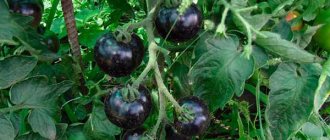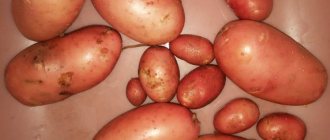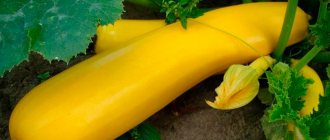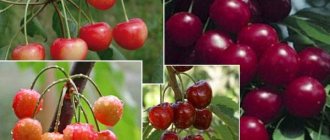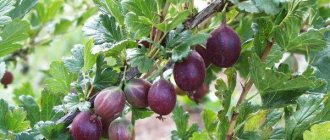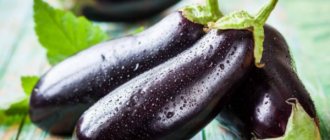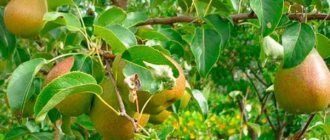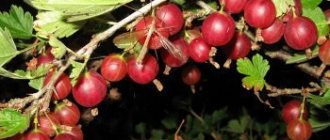There is still snow outside the window in some places, but it is already time for us to prepare for the summer season. And today we will choose the best varieties of tomatoes for growing in open ground. Tomatoes are one of the most popular vegetables cultivated in summer cottages and garden plots. There is a huge variety of varieties, differing not only in color, taste and shape of the fruit, but also in the height of the bushes grown and the timing of harvest ripening.
Experienced gardeners have their own time-tested favorite varieties, among which you will definitely find stunted ones or, as they are also called, determinant ones, that is, “limited in growth.” I’ll say right away that all of them are suitable for open ground. Low-growing varieties are usually called “for the lazy” or “field” varieties because they are unpretentious to growing conditions and many of them do not require garter.
Most low-growing varieties do not require pinching; they quickly and easily begin to bear fruit and delight with a good harvest. Today I will tell you about varieties and hybrids that will appeal to both novice summer residents and experienced gardeners.
Plants with a bush height of less than one meter are considered low-growing. All of them are divided into three groups:
- determinant (bush height up to 100 cm);
- superdeterminate (bush height up to 50 cm);
- as well as standard (compact bushes 50-70 cm high with a small number of stepsons) tomatoes.
The benefits of low-growing tomatoes
- A compact bush that takes up less space in the greenhouse.
- Stops growing on its own.
- Most varieties do not require pinching.
- Early ripening. The development of small bushes requires less nutrients, the rest goes to the formation and development of fruits.
- They can be planted later than conventional varieties.
- If other tomato varieties planted have not sprouted, low-growing tomatoes can be planted as a fallback option.
More information about growing tomatoes is described in the article: Technology of growing tomatoes. Secrets of planting and care
You might be interested in: How to properly plant tomatoes in a greenhouse: bush formation diagram, care features, photos and videos
Useful information: How to properly tie tomatoes in open ground: the best methods, step-by-step photo and video instructions
Features of growing and caring for tomatoes
Low-growing tomatoes are advantageous because they are undemanding and easy to care for. If you follow the agrotechnical rules for growing nightshade crops, an abundant and high-quality harvest is guaranteed.
Watering mode
Excess moisture threatens tomatoes with the occurrence of late blight, and can also provoke intensive development of tops, which, in turn, will negatively affect fruiting, so the soil should not become waterlogged in the vegetable bed. The same goes for drought.
To prevent the plant from wasting nutrients by increasing unnecessary biomass, it is recommended to water the bed 2-3 times weekly. To avoid burns on the foliage, it is better to do this in the morning. It is advisable to use water at room temperature after standing for a day.
We recommend reading how often and how to properly water tomatoes in a greenhouse.
Fertilizer application
To stimulate good yield, tomatoes need to be fertilized at least 2-3 times during the growing season. For the first time, this procedure is relevant already on the 10th day after planting the seedlings; subsequent feeding should be carried out at two-week intervals. If the bushes grow poorly and form an ovary, additional application of complex minerals is required.
All types of tomatoes develop very well after the root application of a solution of chicken manure or mullein. It is important to observe the measure, since an excess of nitrogen-containing components will provoke vigorous growth of the bush and poor fruiting.
Important! In the spring, when daylight lasts about 13 hours, additionally illuminate the greenhouse. Otherwise, there is a high probability of inhibition in the growth of tomato bushes. Then the first inflorescences will appear not on the 7–8th leaf (as it should be), but on the 13th.
Disease and pest control
The slightest violation of growing technology and improper care are fraught with the development of pathogenic microflora and attacks by harmful insects.
All types of tomatoes are, to varying degrees, sensitive to:
- late blight;
- putrefactive infections;
- anthracnose;
- mosaic;
- cancer pathogens;
- spotting (bacterial and brown).
Diseases can be avoided only if the requirements of plants are met and their development is constantly monitored. Treatment is carried out with fungicides (Maxim, Barrier, Hom, Fundazol).
They like to eat the juices of nightshade crops:
- Colorado potato beetles;
- caterpillars;
- root-knot nematodes;
- whiteflies;
- scoops;
- spider mites.
Insecticides (“Aktara”, “Aktellik”, “Bi 58 - New”) will help get rid of sucking guests.
If parasites have penetrated deeply into the soil, it may be necessary to replace the top layer with further deep plowing. Read more about pests and diseases of tomatoes in a greenhouse.
Popular low-growing varieties of tomatoes for greenhouses
Next, we will present a description with photos of the most popular varieties of low-growing tomatoes for greenhouses. They are easy to care for and practically do not get sick.
Important! In the south and central Russia, such varieties can be cultivated even in open areas due to their early ripening.
Mystery
Ultra-early, high-yielding. 80-85 days after the seeds sprout, you can enjoy the first fruits. The determinate bush grows no more than 40 cm in height. Does not require stepsoning. Tolerates lack of light well. Not afraid of nightshade diseases.
Red tomatoes with weak ribbing weigh about 80-100 g. They have tasty, fleshy pulp. They form and ripen in any weather conditions. Universal in use. They do not crack and do not lose their taste during transportation.
Alaska
Early, 90 days after the moment when the seeds sprouted, you can enjoy the first fruits. It is also suitable for cultivation in open ground, as it bears fruit even in short, cool summers.
The determinate bush grows no more than 60 cm in height and requires pinching. Red, flat-round tomatoes weigh about 90 g and have tasty pulp with a rich tomato aroma. Universal to use.
Important! It is recommended to tie the bushes to a support so that they do not fall to the ground when the tomatoes ripen.
If all rules of agricultural technology are observed, up to 11 kg of vegetables are obtained per square meter of plantings.
Honey cream
Early ripening. 95-100 days after the seeds sprout, you can enjoy the first fruits. The bush is semi-spreading, medium-leafed, grows no more than 60 cm in height, and requires periodic pinching. Not susceptible to verticillium and fusarium. Yields 4.2 kg of vegetables per 1 m2.
Seeds are sown from March 20 to April 10. Picking is carried out when 1-2 leaves are formed on each plant. Transplantation of seedlings to a permanent place is carried out in the 1st-2nd decade of May or from May 20 to June 10.
Red plum-shaped tomatoes weigh about 50-70 g and have tasty pulp. Suitable for whole canning.
Aurora
Ultra early ripening. 90 days after sprouts appear from the ground, the first ripe tomatoes can be harvested.
The determinate bush grows no more than 70 cm in height. It has high immunity to tobacco mosaic virus, Alternaria, Fusarium. From each square meter of plantings, up to 12-15 kg of vegetables are collected.
Red, round tomatoes with weak ribbing weigh about 100-120 g. The stalk does not have a green spot. They have tasty fleshy pulp. Universal in use.
After the first harvest, the hybrid grows back and can bear fruit again.
Supermodel
A determinate bush of standard type grows no more than 80 cm in height. Universal cultivation. 110 days after the seeds sprout, you can enjoy the first fruits. With the right agricultural technology, you can harvest about 8 kg of vegetables from 1 square meter. m.
Red tomatoes, plum-shaped and slightly ribbed, weigh about 100-110 g. They have tasty, dense pulp. Universal in use. The fruits do not crack and are not subject to brown spotting.
Golden stream
Early high-yielding variety. The determinate bush grows no more than 80 cm in height.
80-90 days after the seeds sprout, you can enjoy the first fruits. Yellow and orange tomatoes with thick skin have excellent taste and are suitable for fresh and processed consumption.
Red Fang
Very popular among Russian gardeners, as it is unpretentious in care and is not susceptible to nightshade diseases. 85-95 days after the seeds sprout, you can enjoy the first fruits.
Red tomatoes with sweet flesh are versatile in use.
El Dorado
The variety is very popular due to the fact that it never suffers from late blight. Red, oval-shaped tomatoes weigh 120 g and have juicy, sweet pulp. When preserved whole, they do not crack.
Basic rules for choosing a variety
High-quality planting material is the key to a high yield. However, successful vegetable growers do not limit the choice of tomato varieties by purchasing the seeds they like in a specialized store. In order for the resources spent to bring the expected results, it is important to initially analyze the varietal characteristics of the crop, as well as their compliance with the conditions of your greenhouse. After all, each structure, depending on the material, heating and ventilation systems, differs in parameters of temperature, air humidity and soil.
Did you know? Fearing poisoning from tomatoes, Europeans cultivated them for a long time as a garden crop, and the history of America even included the fact that they tried to poison George Washington with a tomato dish.
.
Experts advise when choosing tomato varieties to pay attention to:
- Productivity . If you follow agrotechnical rules indoors, it is quite possible to collect up to 15 kg of fruit from 1 m². Along with the quality of the soil, climatic conditions and care, this indicator is also influenced by the breeding characteristics of the plant. In this aspect, F1 hybrids are preferred, which are distinguished by the preservation of dominant parental characteristics.
- Fruit size . The choice depends on the purpose of cultivation. Large-fruited specimens are more suitable for canning in crushed form. Varieties with medium and small fruits are mainly used for integral preservation.
- Species type of bush. Tall (indeterminate) hybrids are advantageous in that they bear fruit throughout the season, and the harvest from their tops does not become smaller. However, caring for vegetables of this type is very troublesome and requires timely pinching and pinching. Low-growing (determinant) varieties are planted in order to obtain a simultaneous early harvest.
- Disease resistance . Since all greenhouses are closed spaces where there are often problems with dampness, ventilation, inappropriate temperature and sudden changes, varieties with increased immunity are preferred.
- Maturation terms . Agrotechnical practice proves that over the course of a season, about 3 harvests can be harvested from tomato bushes. With the proper purchase of early, mid-season and late hybrids, you can provide yourself with fresh tomatoes until winter.
- Keeping quality and transportability of fruits . F1 hybrids have proven themselves well in this aspect. When choosing, it is worth considering that most varieties in this series have low taste qualities.
- Features of the greenhouse . Summer structures made of cellular polycarbonate are considered cold, so it is better to select more resistant and early-ripening varieties for them. For winter polycarbonate rooms where heating is provided, hybrid varieties with a short growing season will be relevant.
Important! Dampness is fraught with the appearance of fruit flies for tomatoes, feeding on putrefactive decompositions
.
The most productive varieties of tomatoes
The largest yield among low-growing tomatoes grown in a greenhouse is produced by large-fruited varieties. Unfortunately, they cannot be used for whole-fruit canning due to their size, but they are very tasty and can be eaten fresh or processed into juices and ketchups.
Rajah
The determinate bush grows up to 1000 cm in height. Early, 85-100 days after the seeds sprout, you can enjoy the first fruits. The oblong tomatoes weigh 200-300 g and have juicy, sweet pulp.
Pink honey
Mid-season variety with large pink tomatoes. 110-115 days after the moment when the seeds sprouted, you can enjoy the first fruits.
The determinate bush grows up to 100-150 cm in height and requires staking to a support. Tomatoes gain weight 400-700 g, but can also weigh 1 kg. Heart-shaped, sometimes there may be slight ribbing. The pulp is fleshy, juicy, sweet. The skin is dense and does not crack.
This variety can be susceptible to diseases, so it requires careful care and preventive measures.
Grouse
Red tomatoes are round or flattened with intermittent yellow stripes. Do not crack. Great taste without sourness. The bush grows 50-100 cm in height. 110-115 days after the moment when the seeds sprouted, you can enjoy the first fruits.
Harvest and storage times
Depending on the breeding characteristics, the ripening time of tomatoes varies. For some, the growing season lasts about 82 days, while for others it lasts within 130 days. Also, the size of the fruit, its juiciness, the structure of the pulp, the density of the peel, and, accordingly, transportability and storage methods depend on the variety.
If you have to deal with early tomatoes, they are often used for consumption raw. Large, fleshy fruits are processed into juice, adjika, and ketchup, while small and medium-sized fruits are canned or salted whole.
When the harvest period begins, the fruits must be carefully removed from the stems, avoiding cracking and mechanical damage to them. Specimens with thick, elastic skin can be transported over long distances, while more delicate ones are not suitable for such manipulations.
If you want to keep the fresh product until late autumn, you can collect the tomatoes in a box and place it in the cellar, covered with a warm cloth. Fruits that do not have time to ripen in time are more suitable for this.
Among low-growing tomatoes, there are many varieties to suit every taste. We hope our article helped you decide on the best options.
Varieties for the Moscow region and the middle zone
All varieties that were described above in this article are recommended for cultivation in central Russia. In greenhouse conditions they produce a rich harvest, and the fruits ripen quickly.
Next, we will present several more hybrids that are suitable for cultivation in the climatic conditions of the Moscow region.
Askold
Early ripe for salad purposes. Red tomatoes weigh about 60 g.
Boletus F1
Early hybrid. Red tomatoes are heart-shaped and have a great taste. It is recommended to pin the bushes and tie them to supports.
Granddaughter
Determinate bush of standard type. Red tomatoes ripen early and weigh about 20 g. Suitable for canning and pickling.
Dersu
Standard type bush. Red tomatoes weigh about 80g and have an excellent taste.
Fire Heart F1
Early hybrid. The heart-shaped red tomatoes weigh 100g and have an excellent taste. Salad purpose.
Summit
Red tomatoes are cylindrical in shape and have an excellent taste. Suitable for whole fruit canning.
Natalya Dryzhakova, collector from Yaroslavl
The collection includes more than 350 varieties
It's no secret that tomatoes of the same variety in different years of cultivation may differ in taste. And this is due to a number of factors, primarily the growing technology used, nutrition level, soil type, and degree of solar exposure. And yet, to a greater extent, the taste of tomatoes directly depends on the variety they belong to!
I have been growing the varieties that I want to talk about for a very long time.
For several decades now, my legendary old Soviet variety, Bull's Heart, has remained the unsurpassed leader. Popular during the Soviet era and loved by all gardeners, this variety remains a favorite to this day.
This tomato has been in my collection since 1983, and no matter what years I grew it, the variety invariably pleases with its productivity and the unique sweet taste of large, heart-shaped fruits.
Plants of this variety are tall, densely leafy, with large fruits weighing 400-600 g. Tomatoes with dense juicy pulp, rich sweet taste. Good both in salads and for making aromatic juices.
It is preferable to grow in closed ground with the formation of plants with 1-2 stems. It is necessary to tie each fruit cluster to avoid breaking them.
The Monomakh Cap variety is also from a series of classic Soviet varieties - reliable, time-tested and in any weather conditions.
The variety is tall, very productive, with large crimson-colored fruits. The pulp of the fruit is thick, dense texture, rich sweet taste. The fruits are always large - up to 500-600 g, in other years they can reach up to 800-900 g.
In our area (Yaroslavl region), I always grow it in closed ground (nearby greenhouse) with the formation of plants of 1-2 stems. The variety is very responsive to good care, balanced nutrition and fertilizing throughout the growing season.
All the brightness of taste and rich sweetness can only be felt in fruits that are fully ripened on the plant itself, and not in fruits ripened at home on the windowsill.
Among the orange-fruited varieties, one of the leaders in sweetness is the Hawaiian Pineapple. This is a long-time favorite of my collection, I appreciate it for the unusual peach color of the fruit, for its delicate, sweet, aromatic pulp with a predominance of fruity notes.
The variety is tall, I always grow it in closed ground with the formation of plants into 2 stems. Forms clusters with 4-5 large fruits, weighing up to 300-400 g. The pulp inside is two-colored, juicy, with the most delicate sweet taste. I pick the fruits from the plant only when they are fully ripe, then you can fully enjoy the unique taste of these exotic tomatoes.
And how unusually beautiful these plants look in the greenhouse, when at the end of the season, fully loaded brushes with large fruits of a delicate peach color hang on each of them!
I can’t help but name another orange-fruited variety from this series – the Nizami variety. This is an old heirloom variety from Georgia, given to me at the autumn exhibition in 2013.
The variety is tall, mid-season, with an elegant bush structure. The stems of the plants are thin, but strong enough to support large, heart-shaped fruits weighing up to 250-350 g each. The pulp of the fruit is from the “buttery” series, dense, cuts like butter, sweet, with a bright, rich taste.
The variety works better when grown indoors (in our climate zone) and when plants are formed into 2-3 stems. It will thank you for good care, proper agricultural technology and balanced nutrition throughout the growing season with large, sweet, bright orange fruits.
The variety is included in the TOP 10 best sweet varieties every year and has received a permanent residence in my collection.
Varieties for Siberia
It is very difficult to cultivate tomatoes in Siberian conditions. Frosts and temperature changes occur in spring and even summer. However, thanks to the efforts of breeders, tomatoes were developed that can be cultivated in Siberia in greenhouse conditions. Experienced gardeners manage to grow them even in open ground. Such varieties do not need to be planted.
Abakan pink
Early ripening. Tomatoes gain weight of about 300 g.
Alsou
The bushes grow up to 80 cm in height. Red tomatoes gain weight up to 800 g. High-yielding.
St. Andrew's surprise
Mid-season, not afraid of nightshade diseases. Red tomatoes gain weight up to 900 g.
Sugar bison
The bush grows no more than 80 cm in height, each of which produces about 2 kg of tomatoes. Grows and bears fruit well in Siberian conditions.
Red tomatoes with pronounced ribbing weigh about 120 g.
General description and classification
Tomatoes of the group according to stem height are divided into the following types:
- ordinary: determinant (the main feature is considered to be limited growth up to 1 m) and superdeterminant;
- standard - height varies between 0.5-0.7 m, they are compact, have a thick shortened stem and the presence of a small number of stepsons;
- creeping.
Low-growing tomatoes include super-determinate varieties with a stem height of up to 0.6 m (the main difference is the formation of 3 clusters, after which stem growth stops), as well as standard varieties. Some determinate plants, despite the stated height of the stem, due to many factors, grow no higher than 0.6-0.8 m.
According to the ripening period, they are distinguished:
- ultra-early (super-early);
- early;
- average;
- late.
Varieties for the Urals and northwestern regions
Summer is short in the Urals. Therefore, it is also not easy to grow tomatoes in this region. The main thing is to choose varieties that were created specifically for the conditions of the Urals. When grown in a greenhouse they give a good harvest.
Biathlon F1
High-yielding. Red tomatoes weigh about 90 g.
Alaska
They give a good harvest in any climatic conditions. Salad purpose. Red tomatoes weigh about 80 g.
Boni MM
Early ripening. You can enjoy the first fruits already in early July. Almost never gets sick. Red tomatoes weigh about 90 g.
Precocious/early
Many low-growing tomato varieties are characterized by early ripening, which is especially important when grown in regions with short summers. In this category, you should pay attention to the following seeds:
- Pearl. The harvest can be harvested within 87 days after planting in the greenhouse. These will be medium-sized tomatoes weighing 30-40 g. There are three color options: red, pink and yellow. The plants themselves do not require complex care. It is enough to apply complex fertilizers and tie up the trunk so that it does not sag under the weight of ripening fruits.
- F1 doll. A low-growing hybrid with a ripening period of 85 days. On 1 m² of land you can get up to 9 kg of harvest with fleshy, sweet pulp, which can be used for various needs.
- Arctic. An unpretentious variety that tolerates temperature changes and lack of moisture well. Bushes up to 40 cm high do not require a garter and produce up to 25 round small tomatoes each. They begin to bear fruit in 80-87 days.
- "Katya F1". Hybrid with a ripening period of 75-80 days. Productivity reaches 12-14 kg per 1 m². One bunch produces 7-8 tomatoes weighing 90-130 g each. They have a round or flat-round shape, good taste with sweet notes.
- Visible and invisible. An early, low-growing variety with abundant fruiting, therefore, despite its small height (up to 40 cm), it requires a garter. Round, slightly flattened tomatoes are not prone to cracking. They come in two colors: pink and red. The first harvest will be larger (up to 280-330 g), subsequent ones - up to 200-300 g. You can get up to 4-5 kg of vegetables from a bush.
- Sanka. One of the best early varieties. Ripening occurs after 90 days and can last until frost. Productivity reaches 13-15 kg per 1 m². Thanks to their thick skin, the scarlet round fruits are suitable for salads, pickling, and pickling.
Related article:
Tomato Chio-chio-san F1 – description of the popular variety, characteristics and reviews
Plants with a minimum ripening period will also be the best option for greenhouses infected with fungi or bacterial infections: the crop will ripen before the pathogens develop en masse.
Peach
Orange tomatoes weigh about 90 g. For salad purposes.
In this article, we presented the most popular and best low-growing varieties for greenhouses, which can be grown in the conditions of Siberia, the Urals and the Moscow region, the middle zone, the north-west and south of Russia. It is worth noting that most varieties on this list require regular watering and sufficient sun. They also need to be fed and grown in fertile soil. As these conditions change, the yield will also change.
Watch the video! Is it worth planting low-growing tomatoes in a greenhouse?
How to choose
Before choosing low-growing tomatoes for your plot, it is worth considering some basic points:
- Climate of the region. For the northern part and middle zone, cold-resistant and early-ripening tomatoes are recommended. They are resistant to various diseases, in particular late blight. Early fruiting will ensure the safety of vegetables, since it occurs before the first signs and active phase of the disease appear.
- Soil quality.
- Compactness and height of stems.
- Rate of maturation.
- "Immunity" to diseases.
- Type and form, use after collection.
- Productivity.
- Care.
Related article:
Caring for tomato seedlings after picking
